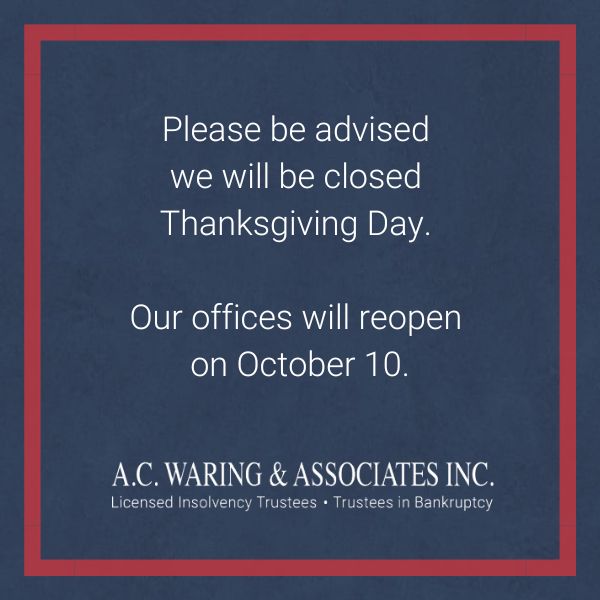Many people are under the impression that bankruptcy ruins their future chances of getting a mortgage. While bankruptcy can certainly set plans back and requires that you work with a Licensed Insolvency Trustee (LIT), it can also provide a viable solution to your current debt problem.
After you are discharged from bankruptcy, you may be able to obtain a private mortgage as soon as a day after your discharge. However, a prime mortgage could require you to be discharged from bankruptcy for a minimum of 2 years. This was the criteria for CMHC to consider insuring a mortgage. Additionally, there may be other requirements that may vary between lenders.
If you cannot avoid bankruptcy and your plans include a mortgage, it is often in your best interest to begin working on reestablishing credit worthiness as soon as possible by following plans and strategies that can bring you closer to your goal. Of course the best way to re-establish one’s credit is to pay your bills on time.
What Is Bankruptcy?
Personal bankruptcy is claimed when someone cannot repay their debts, regardless of the reason. Although some may view bankruptcy as an easy solution to getting out of debt, it is a serious decision.
In order to file for bankruptcy a debtor first outlines their financial situation with their LIT. This includes their personal information, financial information, and a list of assets and liabilities. During the bankruptcy proceedings, your LIT is responsible for monitoring your income, usually for a period between 9 and 21months.
How Long After Bankruptcy Can I Get a Mortgage?
During bankruptcy, lenders are unlikely to grant you a mortgage, but you can still make payments on your secured loans, like car loans or an existing mortgage if you have one. That being said, there are several mortgage options you may be able to consider after you are discharged from bankruptcy.
Traditional Mortgage
A traditional mortgage is typically the most desirable type of mortgage. There are variables, such as fixed-term versus variable-term mortgages, but for the most part, a traditional mortgage offers preferable interest rates.
Some lenders have strict restrictions for traditional mortgages, so there may be more flexible options than a traditional mortgage following bankruptcy.
General qualifications for a traditional mortgage may include, but are not limited to:
- Discharged 2+ years from bankruptcy
- Stable income source
- 600+ credit score
- As low as 5% of the purchase price as a down payment
Timing is often the most significant factor when you are declined a traditional mortgage after bankruptcy.
Subprime Mortgage
Following bankruptcy, a subprime mortgage may be another option you can explore with your broker. These mortgages share many similarities with traditional mortgages. However, some notable differences include less time needed following your discharge and lower credit score requirements.
But these relaxed qualifications typically come at the cost of a higher interest rate. Sometimes, the increased rate can be as much as double the amount of a mortgage from a bank.
Private Mortgage
A private mortgage may be another option for individuals who want to get a mortgage soon after their bankruptcy discharge. In many cases, you may be considered for a private mortgage shortly after your bankruptcy discharge without concern about your current lack of credit statistics..
However, this typically comes with a much higher interest rate, a high minimum down payment (usually around 15%), and a lender commitment fee of anywhere from 10 to 20 per cent.

Improving Your Credit History
It may be possible to avoid bankruptcy, but even if you pursue debt consolidation or a consumer proposal as a financial solution, there is a good chance your credit history will not be ideal from a lender’s viewpoint. Each person’s situation is a little different when it comes to obtaining new credit sources.
Secured Credit Cards
Following bankruptcy, a secured credit card is one option for having the privilege of using a credit card. . A bank offering a secured card will take a deposit, typically $200–$500, and keep it as collateral on the credit card.
Keeping this credit card in good standing may help your ongoing credit history.
Secured Loans
A secured loan, like a car loan is similar to a secured card, but instead of taking a deposit, the loan is tied to other collateral. Most people choose to keep paying on their automobile loan after they file for bankruptcy. Paying these loans on time may provide you with some ongoing positive credit bureau history.
Review Your Options with A. C. Waring & Associates
Bankruptcy is not the end of your financial life—it is a setback you can overcome with the right people in your corner. If you are struggling with too much debt, do not wait until it is too late.
Contact our office today and let the professional team at A. C. Waring & Associates answer all your questions. We provide free consultations for you to get the financial advice you need.





